Framing Statement:
At 10.30am on Friday 6th May, the first audience member came along to Churchill’s Café on Lincoln high street, to experience the individual site specific performance of ‘Record(ing)’. The audience member arrived at the time they had previously been given having expressed an interest in viewing the performance. Half hour slots were allocated throughout the day via a private Facebook event that was made by myself and the other creators of the piece; Simon Panayi, Samantha Miles and Josh Pearson. The performance itself took the form of an audio and visual tour that gave the audience an experience of Lincoln’s high-street. The audience member was taken on a journey from inside the café, to a car park further down the high street and then back again. However, this wasn’t done by asking the audience member to physically travel this route, but instead the performance took place from within the café as the viewer sat and watched the journey via an electronic tablet. Upon arrival, the participator would enter Churchill’s and wait to be greeted by the waiter/waitress. When acknowledged, the audience member would say “I am here to see Record”. They would then be shown to a reserved table within the café, upon which they would find a tablet, wireless headphones and a sheet of instructions explaining what they are to do. From that point the audience member would sit and follow the instructions that would eventually lead them to watch the 19-minute performance whilst enjoying a warm drink or plate of hot food, should they have chosen to order something.
Our performance had two main goals behind its contextual meaning. Firstly, to encourage the audience to ‘notice the un-noticed’ as they voyaged the high-street. We felt that we often make similar journeys to travel to and from particular destinations. But, we rarely notice minute details or stray from the usual path in order to experience certain aspects we wouldn’t usually come across. And as Govan say’s “in this period of globalisation and cyber space, theatre practitioners are interested in rethinking how people relate to land-scape and place” (Govan, Nicholson and Normington, 2007, 136) and this was exactly what we wanted to do. We also wanted to give the seemingly insignificant aspects of the highs-street, significance. Whether this be objects that were found on journeys of the high-street, parts of buildings that appear to have no meaning, or places that seem to serve no purpose and look un-maintained. In doing this we hoped to change people’s perceptions of everyday occurrences and journeys. We hoped to encourage them to realise that whilst on first glance something may appear boring and mundane, all of these aspects have potential for meaning and relevance to the place they are found or experienced in. We wanted them to appreciate that perhaps these features give us a clue to the sites past or give us information about the sort of people that have passed through the location. You just have to take the time to analyse or explore them.
My biggest influence during this process was Georges Perec and his site specific work ‘An Attempt at Exhausting a Place in Paris’. He spent 3 days sat in a café, sitting, observing and capturing the outside world using only a pen and paper. His intentions were to point out “that which is generally not taken note of, that which is not noticed, that which has no importance: what happens when nothing happens other than the weather, people, cars and clouds”. (Perec and Lowenthal, 2010, 3) He described his findings as the ‘infraordinary’. It was because of this personal fascination of his work and the idea of the ‘infraordinary’, which guided us in the right direction to reach our final performance. After researching his work in detail, we began thinking about how we might create a similar style of performance that instead investigates Lincoln’s high-street.
Analysis of Process:
We began by investigating the high street using Carl Lavery’s instructional method. This technique used a specific question such as “Take photographs of ten buildings in the city that fill you with inconsolable sadness” (Lavery, 2005, 233) in order to explore the city in a new way, or experience a part of it you have never been to before. (Lavery, 2005, 233) We carried out this instruction and photographed buildings that made us feel this way.
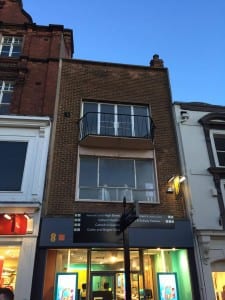
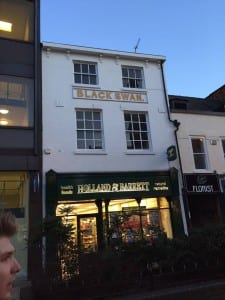
This was a big step for us as a group, as up until this point we had struggled to really get on board with site specific performance. However, after getting over the initial silliness of the experience, we began to think seriously about why these buildings made us feel this way and analyse them in much more detail. This led onto our next stepping stone as we began to consider how the buildings might react if they were to be given human qualities. In particular, we experimented with what a building might do if it was to make an impulsive sound or noise to show how it was feeling. Furthermore, I suggested that we select particular visual features of the buildings that we found insignificant and discuss why. I explained the concept of Georges Perec’s work ‘An attempt at exhausting a place in Paris’ and suggested we include the topic of ‘noticing the un-noticed’ as theme/stimulus for our piece. We agreed that it would be interesting to try and change people’s perception of a place they probably frequent regularly. Or, at least highlight elements they had never experienced before.
Having photographed the buildings in previous weeks, we had since developed on this by also photographing what we considered insignificant aspects of the buildings. Our next step involved us contemplating how we might go about turning these ideas into a performance. We had recently been introduced to the site specific work of Marcia Farquhar and her live art tour at the Festival of Britain which took place on the South Bank. I enjoyed her work, whist others in the group did not. However, we agreed that weren’t so interested in the topics of her tour, which included ideas of history and memories. But more so, in the inspiration she had given us to create a tour of the high street and as Marcia puts it “layering… and how places do sort of resonate with what has happened”. (REcreativeUK, 2012)
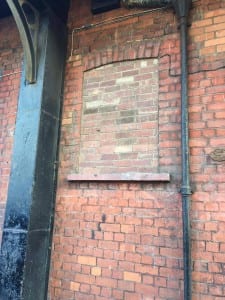
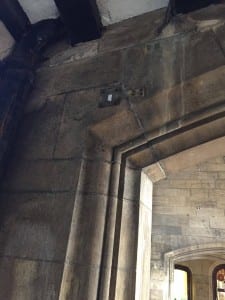
This idea of layering, led us to think about creating an audio tour that would give the audience a personified view and experience of different buildings or places that the tour took them to. By literally layering audio, we knew we could show the complexity of each buildings characteristics, its’s insignificant features, how it may be feeling through resonating sounds and what might have happened in or to this building in the past. Therefore, fulfilling the concept of changing people’s perceptions of the high-street by encouraging them to ‘notice the un-noticed’ and appreciate the seemingly less important features.
For a while we became stuck, we couldn’t figure out an innovative way to run the tour. Eventually, we stumbled onto the topic of QR codes. We discussed them as a means of the audience logistically accessing our audio, which we would place independently at each of our locations. And so, we set about trialling this over the course of feedback week.
Having successfully tested the idea at two of our locations; the archway and the car park, we reflected heavily upon what worked and what didn’t. The tour was designed to be an independent exploration of the high-street. For this reason we gave the audience a map and placed a QR code at each of these locations which gave the audience clues as to where they had to go. They could then choose the route they took to get the locations. Once they had arrived at the destination on the map, the audience had to find the QR code that was located somewhere in the area. Once they found it they had to scan it using the pre-downloaded app which we had asked them to install before trailing our piece. They would then listen to around 2 minutes of carefully layered and edited audio that expressed the location.
We carefully evaluated the success of this tour and sought to improve it. For me, there were several flaws that needed drastic development. Firstly, I noticed that many of the audience struggled to find the QR code after arriving at the destination. In fact, the majority of them were only successful in doing so because they saw others scanning it. Secondly, no one seemed to realise that they could also scan the QR codes on the map. As well as showing the audience where they had to go, these were also a link to another audio file which included the resonating sound of the location. This was my idea as I felt it offered an insight to the location before the audience arrived there. Thirdly, I noted that whilst the audience walked to and from the destinations they didn’t appear to be engaging with the city around them. Instead they just continued checking their phones or talking with those around them. This didn’t meet the aims of our piece. Finally, I received feedback from some audience members who said that whilst the content of the audio was very interesting, it was hard to know what features were being discussed. Consequently, some audience members didn’t end up noticing the aspects they should, as they didn’t know what to focus on. This meant our current piece didn’t successfully achieve the goals of our idea.

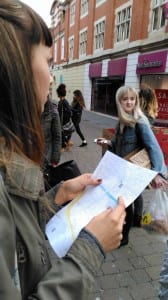
After considering our feedback, we attempted to re-fresh our ideas towards the logistics of the tour, by going back to the drawing board and each researching more site specific practitioners in detail. Simon suggested we take a look at the site specific work of Janet Cardiff and George Bures Miller. They created a video experience where “overlapping realities lead to a strange, perceptive confusion in the viewer’s brain”. (Cardiff Miller, 2012) The viewer watches a video, of another video that is displayed on an iPhone in front of them. Both videos are focused on the same spot in Anhalter Bahnhof, a former railway terminus in Berlin. However, both show different things within them as time has clearly elapsed since the first recording was shot. In addition, they choose to include performers within the piece to add elements of surprise and abnormality. For example, a ballerina enters the shot and begins performing a ballet sequence. This is visually stimulating as you generally wouldn’t expect to see this at a train station. As the experience progresses “the real sounds mix with the recorded adding another level of confusion as to what is real and what is fiction”. (Cardiff Miller, 2012) We loved the concept of incorporating video footage into our piece, as we knew it would give us the opportunity to further alter the viewers experience of the high-street. Just as Cardiff did. We began experimenting in the style of her work.
Having gained an immense amount of knowledge over the past several weeks and experimented with different ideas of site specific work. It was now time to begin to finalise our ideas and create our end product. Firstly, we discussed exactly what we wanted to achieve with the tour’s audio. We agreed that it would be made up of all the artefacts that we had gathered from our key location, the car park. We chose this site because of our own fascination and curiosity towards it, as well as being somewhere none of us had ever noticed despite travelling the high-street many times. We wanted to share this location with our viewers. Some of the materials we found at this location included; the book ‘Dames Don’t Car’, the Vinyl ‘Symphony Number 2’ and a set of instructions outlining how to operate a car. We felt these items gave us plenty of interesting information to create an audio track that gave the audience an experience of the site. However, we agreed that we would edit and manipulate our recordings in order to generate an ‘infraordinary’ experience. It also acted as a way of presenting the artefacts that we had specifically ‘noticed’. We wanted use the audio to show them to our audience as they would have probably usually gone un-noticed.
In terms of the video, we came to the conclusion that we would record a single journey that began at Churchill’s café. We chose Churchill’s as the location for our performance as it seemed appropriate having discussed so much of our devising process there. The recording would then travel all the way down the high-street, ending up at the car park and the returning back up to Churchill’s where it began. This was important, as it would give the audience an opportunity to explore the video and notice aspects of the high-street they hadn’t previously before. Whilst the audio accompaniment would not only affect the mood, but create a feeling they may not get on the usual journey of the high-street. Furthermore, we used the audio to highlight moments within the video. By fitting the timing of the two together, the sounds drew the audience’s attention to the movement.The only thing we specifically didn’t want in our tour was staged performers. Whilst Farquhar and Cardiff purposely added them in, we felt it would draw the audience away from noticing features of the high-street. Hence, during the performance day we remained out of sight upstairs in the café.
An Example of Our Visual Footage (Petherick, 2016)
Evaluation:
Miwon Kwon suggests that the site itself offers “a tangible reality, its identity composed of a unique combination of constitutive physical elements: length, depth, height, texture”. (Kwon, 1997, 85) Our piece offered the opportunity to explore these areas of the high-street and discover it as a site.
Our final performance was an individual experience that one audience member viewed at a time. We hoped that they would find the experience both unique in its approach to a tour of the high-street, as they remained inside the comfort of Churchill’s café. But also, offering a fresh, insightful view of it, that they probably haven’t experienced or considered before. Once seated, prepared with the tablet in hand, headphones placed comfortably on head and video started. The audience would witness the view of Churchill’s that they would currently see in front of them, but through the screen of the tablet. Giving them a ‘point of view’ shot’. The video then continued by rising and leaving the café, giving them the impression that it is in fact them leaving Churchill’s and continuing on the journey down the high-street. Whilst travelling they would have heard music, recorded dialogue and sounds of the landscape accompanying the video. However, it had been edited and manipulated to alter the viewers experience and give them an original and new understanding of the high-street.
I feel that the strongest aspect to our performance was the incorporation and portrayal of the materials, artefacts and sounds that we had gathered during the creative process. These were combined using the audio and visuals in such a way that challenged the audience’s usual perception of the high-street. For example, we recorded the sound of the alarm warning pedestrians that the crossings will be coming down shortly due to the presence of a train. We then drastically slowed the speed the sound was played, which gave a resulting effect similar sound of turning waves. We then chose to play this sound as the video crossed the road. Whilst crossing the road is usually a process that requires a lot of concentration and awareness, the sound of waves changed my impression of this and made me feel much calmer and relaxed. Successfully altering my perception of the high-street at this point and what I associate with the journey.
Having evaluated the outcome of our performance and assessed whether it successfully does what we intended it to do. There is one particular aspect I would change. I would have chosen to specifically highlight features of the high-street I deemed insignificant by zooming in and focusing on them. Or, by including some form of sign that points out the insignificant details to the viewer. Whilst I feel our final performance gave the audience the opportunity to notice the ‘un-noticed’ themselves, by actively scanning the footage. I feel it may have been more successful had we offered them specific examples throughout the tour.
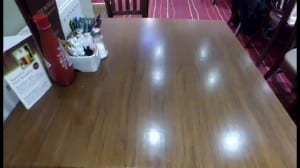
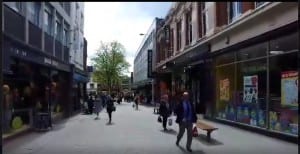
Bibliography
Cardiff Miller (2012) Alter Bahnhof Video Walk. [online video] Available from https://www.youtube.com/watch?v=sOkQE7m31Pw [Accessed 09 May 2016]
Govan, E., Nicholson, H. and Normington, K. (2007). Making a performance. London: Routledge.
Kwon, M. (1997). One Place after Another: Notes on Site Specificity. October, 80, p.85.
Lavery, C. (2005). Teaching Performance Studies: 25 instructions for performance in cities. Studies in Theatre and Performance, 25(3), pp.229-238.
Perec, G. and Lowenthal, M. (2010). An attempt at exhausting a place in Paris. Cambridge, Mass.: Wakefield Press.
REcreativeUK (2012) Marcia Farquhar – A live art tour. [online video] Available from https://www.youtube.com/watch?v=1Li90TEcsUw [Accessed 09 May 2016]